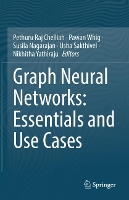


|
|
|
books
| book details |
Graph Neural Networks: Essentials and Use Cases
Edited by Pethuru Raj Chelliah, Edited by Pawan Whig, Edited by Susila Nagarajan, Edited by Usha Sakthivel, Edited by Nikhitha Yathiraju

|
This book is currently unavailable. Enquire to check if we can source a used copy
|
| book description |
This book explains the technologies and tools that underpin GNNs, offering a clear and practical guide to their industrial applications and use cases. AI engineers, data scientists, and researchers in AI and graph theory will find detailed insights into the latest trends and innovations driving this dynamic field. With practical chapters demonstrating how GNNs are reshaping various industry verticals—and how they complement advances in generative, agentic, and physical AI—this book is an essential resource for understanding and leveraging their potential. The neural network paradigm has surged in popularity for its ability to uncover hidden patterns within vast datasets. This transformative technology has spurred global innovations, particularly through the evolution of deep neural networks (DNNs). Convolutional neural networks (CNNs) have revolutionized computer vision, while recurrent neural networks (RNNs) and their advanced variants have automated natural language processing tasks such as speech recognition, translation, and content generation. Traditional DNNs primarily handle Euclidean data, yet many real-world problems involve non-Euclidean data—complex relationships and interactions naturally represented as graphs. This challenge has driven the rise of graph neural networks (GNNs), an approach that extends deep learning into new domains. GNNs are powerful models designed to work with graph-structured data, where nodes represent individual data points and edges denote the relationships between them. Several variants have emerged: Graph Convolutional Networks (GCNs): These networks learn from a node’s local neighborhood by aggregating information from adjacent nodes, updating the node’s representation in the process. Graph Attentional Networks (GATs): By incorporating attention mechanisms, GATs focus on the most relevant neighbors during aggregation, enhancing model performance. Graph Recurrent Networks (GRNs): These networks combine principles from RNNs with graph structures to capture dynamic relationships within the data. GNNs are applied in a variety of advanced use cases, including node classification, link prediction, graph clustering, anomaly detection, recommendation systems, and also in natural language processing and computer vision. They help forecast traffic patterns, analyze molecular structures, verify programs, predict social influence, model electronic health records, and map brain networks.
| product details |
Normally shipped |
Publisher | Springer International Publishing AG
Published date | 27 Aug 2025
Language |
Format | Hardback
Pages | 418
Dimensions | 235 x 155 x 0mm (L x W x H)
Weight | 0g
ISBN | 978-3-0318-8537-2
Readership Age |
BISAC | computers / neural networks
| other options |
|
|
|
To view the items in your trolley please sign in.
| sign in |
|
|
|
| specials |
|
|
Our moment has seen the resurgence of an anarchist sensibility, from the uprisings in Seattle in 1999 to the Occupy movement of 2011.
|

|
André Alexis
Paperback / softback
176 pages
was: R 315.95
now: R 283.95
|
A pack of dogs are granted the power of human thought - but what will it do to them? A surprising and insightful look at the beauty and perils of consciousness.
|
|
|
|